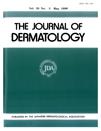Macular Amyloidosis: Etiological Factors
Abstract
Macular amyloidosis is the commonest form of primary localized cutaneous amyloidosis; its etiology remains unclear. Various incriminating factors include genetics, sunlight, and fricition. Seventy-five patients with a clinical diagnosis of macular amyloidosis (confirmed by at least two observers) were enrolled in the study. A detailed history was elicited in relation to the etiological factors and followed by cutaneous examination. Skin biopsy was performed in 44 patients. Amyloid deposits were demonstrated in 21 (48%) of the biopsies. The female to male ratio was over 3:1. Patients with skin type V had a more delayed onset than those with skin types III and IV. Two patients gave histories of regularly subjecting their skin to friction. There was no correlation between the sites affected and the sites subjected to friction, hair style of the patient, or the use of cosmetics. Family history was present in 7 (9.3%) patients. A majority, 44 (58.7%) of the patients, had involvement of both sun-exposed and sun-protected sites. To conclude, there was no direct correlation between macular amyloidosis and atopy, sunlight, or friction to the skin in our patients. Multiple factors may play a collective role in the genesis of macular amyloidosis to variable degrees. These include racial, familial, and environmental factors, atopy, sunlight, friction, and female gender.




